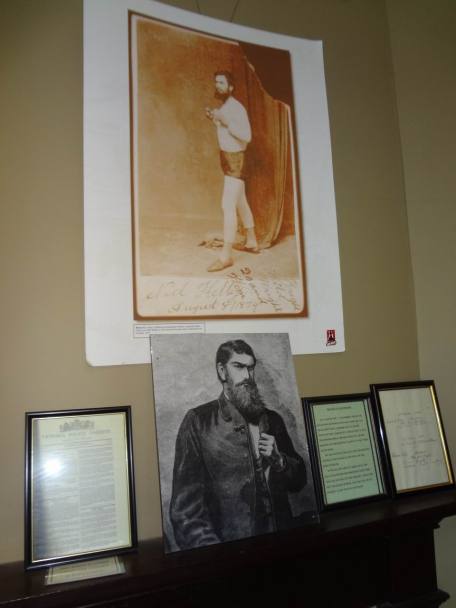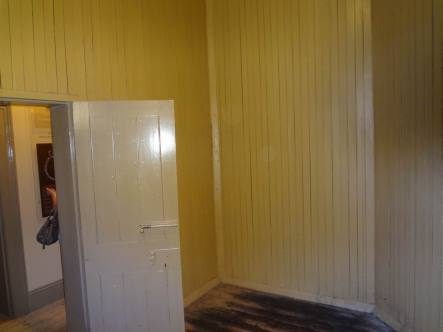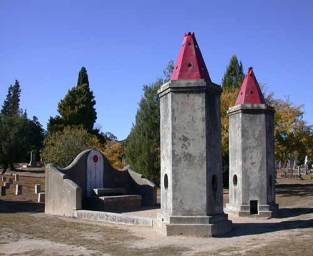Next day we repacked the car and headed to Beechworth in Victoria. The drive was just over two hours, via the outskirts of Albury. It was an easy drive, and once off the freeway a very pleasant drive along quiet country roads.
Finding our accommodation Rose Cottage was easy.

Rose cottage from the front gate.

View from the small patio outside our room, very peaceful with a glass of wine.
The decor is ornate country cottage, with a homely feel of yesteryear. The cottage has a large number of interesting pieces, which held my attention. Where ever I went there was something different and many pieces reminded me of an elderly Aunt’s home that I used to visit as a child. She lived in Caernarvon, North Wales, and her home was country-ish. Of course in Rose Cottage everywhere was rose coloured.


Entrance hall Our room – the teddy bear is not mine!
Our room wasn’t quite ready when we arrived, so were offered two free vouchers to try out the local pub called The Hibernian, which was a short walk (about fifty metres) from Rose Cottage, just in time for a pre-lunch drink. A very friendly pub with good food and cold beer – couldn’t fault it.

Beechworth is a piece of ‘yesterday’, quiet streets, which are very wide, friendly locals, and because we were out of season (just before Easter) it was a pleasure to just wonder in and out of shops to check out the local produce (mainly honey), and wine.

Old buildings and quiet streets


During our stay we saw much of the Ned Kelly gang era, from their last stand and gun fight, to Ned Kelly being committed for trial in Melbourne, where he was found guilty of murder, and November 1880 hanged at the age of 25.


The above is Ned Kelly’s death mask.
The old court house is as it was in the 1870’s and all of the furnishings, including the large clock, were used in that period.

This the holding cell where Ned Kelly waited to be called in to court.

The picture behind me shows Ned Kelly standing in the same dock during his committal hearing for the murders of Constables Scanlon and Lonigan.

The last time this court was used was in 1989, after 131 years of continual service.
It is believed that Harry Power, (also known as Johnson) later known as ‘the Gentleman Bushranger’, was Ned Kelly’s tutor in his life of crime. Power is virtually unknown today.
The picture below is of the original cell, under the town hall, where he (Power) was held in Beechworth before being sentenced to fifteen years for armed hold ups.

Harry Power retired from a life of crime, after finishing his fifteen years in gaol, in 1885. He was an old sick man and used to earn a living as a tour guide around ‘Success’, which was the prison ship in which he had served seven years, as a prisoner. He was known as ‘The last of the bushrangers’.
In 1891 he drowned in the Murray River at Swan Hill, so ending the era of the ‘Bushrangers’.
As we walked from historic site to historic site we were always greeted by people in traditional dress of yesteryear, including many of the men wearing long beards of the period of the 1850’s to 1870’s, all genuine. The people involved with the history of the town were, I believe, volunteers and their labour of love shows through, via their enthusiasm.
Next to the Court House is the telegraph office where one can still send a message via Morse code. It opened in 1857. As with many Beechworth places of interest there is always a volunteer in attendance. The elderly gentleman who was happy to talk to use and show us how everything worked used to be a ‘key-man’ from way back. We spoke of the differences between his day on land and a ship’s Marconi radio operator when I was at sea.
For a small fee he would send a message, via Morse, anywhere in the world. It turned out that the message went to someone in Melbourne, and after that it went by post to its destination. The Morse system is operated by volunteer hobbyists, so sending within Australia was not a problem because locale hobbyists would decode and post locally within Australia, but internationally it was a problem, but by using the snail mail postal system the message would reach its destination – eventually.
It was suggested to us that we drive to the top of Mount Stanley for views of the Victorian Alps. This sounded a good idea so we set off and drove to Stanley, the small town at the foot of the mountain. As we approached the lower part of the mountain the road became a dirt road.
The dirt road was not a problem as we climbed higher and higher until it started to get very narrow, with a cliff edge on one side and forest trees on the other. Glimpses of a very good view could be seen occasionally by Maureen, but I was not in the mood to take my eyes off the road, which was getting narrower still, and a puncture would be a major problem on the steep incline.
In addition I was concerned that if we met another vehicle coming down the mountain we would not have enough room to pass, and one of us would have to reverse a considerable way.
Eventually we came across a small area where the road was a little wider, with a small cutting in to the woods to allow cars to pass. I took advantage of this area to turn the car around and return to civilisation. The last thing I wanted was any serious damage to the car as we had only just started our road trip.
Later when we mentioned this aborted trip in our B & B we were told that the view was not very good because the trees had grown so tall that many obscured the Alps. Apparently the green brigade objected to the pruning of the trees to maintain the views.
On our list of ‘must see’ was a cemetery, which when you think about it is an unusual holiday destination. The cemetery is famous for the Chinese connection with its many graves and Chinese shrines from the gold rush days.
Chinese Burning Towers.
 The relatives and friends of the recently died would burn prayers and meals provided to help the Spirits on their way. Over 2000 Chinese are buried in this cemetery.
The relatives and friends of the recently died would burn prayers and meals provided to help the Spirits on their way. Over 2000 Chinese are buried in this cemetery.
Picture from the cemetery’s web site.
As we respectfully checked the Chinese area, a local introduced himself as the Manager of the cemetery and asked if he good he help?
I explained that we were visiting from Sydney and that we were interested in the old graves. From then on the Manager was a fund of knowledge of the ‘old days’ and brought to life (excuse the pun) the history of the cemetery and how the Chinese section grew. The areas which we thought were ‘blank’ as if waiting for the next funeral where in fact graves of paupers or the mentally ill from the local mental institution, which no longer exist. Many of the mentally ill were abandoned by their family, and the patient was never visited. When they died relatives failed to claim the body, so they were buried in the pauper’s area. In some cases the family had left the area and the authorities were unable to trace their new address.
There were a number graves pointed out by the Manager, which were famous. I’ve listed three that I found interesting.
John Drummond; born 1791 in Scotland. He joined the 71st Regiment at 15, and served in eleven battles during the Peninsular Napoleonic war. He fought at the Battle of Waterloo in 1815.
He was wounded in 1811 and 1813, and discharged from the army as a sergeant in 1828 ‘worn out through length of service’.
He arrived in Australia in 1831, and perhaps the gold attracted him to Beechworth in the 1850’s. He was a caring man because in 1858 he gave up his army pension for the widows and children of those killed in the Crimea war. He died at 73 years of age in 1865. He is thought to be one of only ten men in Victoria who fought at Waterloo.
James Riley; born New Jersey in 1829. He enlisted in the American Army in 1862, and was badly wounded in the right leg at the battle of Reams Station on Weldon Railroad. He turned up in Beechworth and married in 1886, a local widow. He died in 1901.
James Storey; born in New York in 1818. He enlisted in the 2nd US Dragoons in 1840 and fought against the Indians (Seminole Indians I think), in the West. He re-enlisted in 1845 and served in the Mexican War between 1846 and 1848. He fought at the battle of Palo Alto, Resaca de la Palma, Monterey and Beuno Vista, where he had his horse shot from under him.
In 1850 he went gold digging in California, and in 1853 he arrived in Beechworth looking for gold. In 1858 he married an ex-convict, who had been transported from England for theft in 1839. He died in January 1913 at the age of 95, and is buried with his wife in Beechworth cemetery.
In 1932 the last Chinese person was buried in the Chinese section, he was 105 years old, having lived in Beechworth for over 70 years.
Without the Manager I doubt that we would have gained so much from our visit.
From the cemetery we decide to visit the carriage museum. It wasn’t easy to find, but we did find it in the grounds of a brewery.

We seem to have visited a number of places in Beechworth linked to death, perhaps it is our age that we can look upon the trappings of death, without being part of the main scene – yet.
I noticed that the brewery offered ‘tasting’ so after viewing the various carriages I felt in need of a few tastings, so we entered the brewery. I asked about the type of beer that they brewed and was told that they didn’t brew beer, but cordial! A ‘cold one’ was not forthcoming.
To be fair, the cordial tasted very different than the supermarket type cordials. The history of this brewery was interesting.
They had an area dedicated to the story of the brewery, which opened in 1865, brewing beer. It wasn’t until the Temperance Society became involved in the 1920’s that the brewery changed from beer to cordial. It is located over an underground spring of pure water, for both the beer and cordial. The brewery is called Murray Breweries, and it wasn’t until I left Beechworth that I found out that the local beer brewery is Bridge Road Brewers, and they offered real local ale. You win some and loose some, but Murray Brewery was enjoyable, if different.

Very interesting photos! The Rose Cottage looks lovely and welcoming. ☺
LikeLike
Thank you – The bed was so high they supplied a small stool for short people to get in to bed . . . overall I enjoyed the stay :-o)
LikeLiked by 1 person
Love your cottage…looks lovely!
LikeLiked by 1 person
It was very pleasant, and close to everything – even Ned Kelly’s gaol was only round the corner :-o)
LikeLiked by 1 person